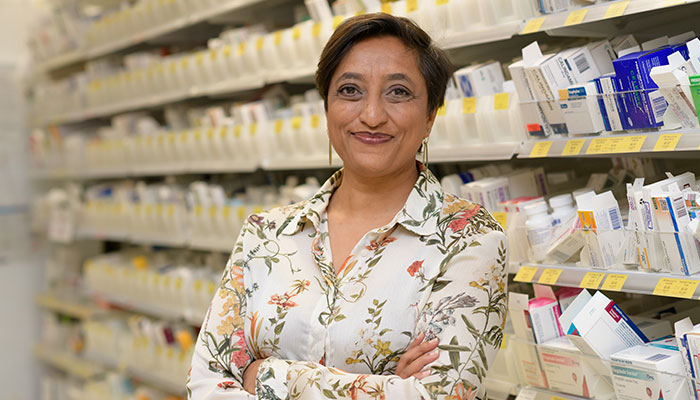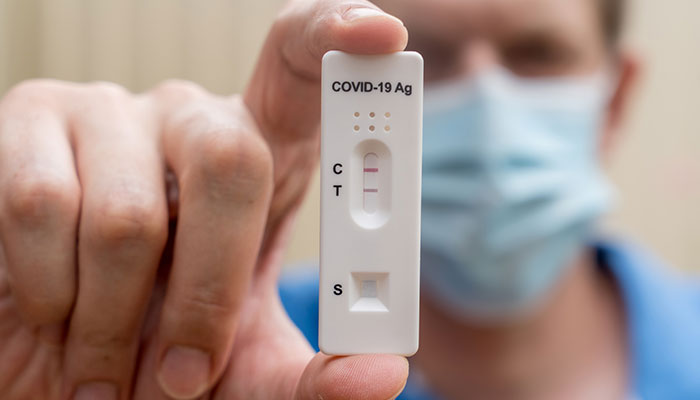Vaccines work through an ‘expose-response’ mechanism. Vaccination trains cells in the body’s immune system to recognise and respond to an infection. We train the immune system by exposing - vaccinating - it to molecules (antigens) from a virus or bacteria.

Unprecedented collaboration: achieving a vaccine in 12-18 months is normally unheard of says Professor Amin, but the world has not seen the current level of international partnerships and technological advancement before.
These molecules are either parts of the pathogen or an inactivated version of the pathogen, (which means its unable to infect but still capable of triggering an immune response.
This immune response is created without you getting as sick as you would if you were infected with the pathogen from the environment, which is known as a ‘wild-type’ infection. Some of these immune system cells have long memories and the next time the body ‘sees’ the same or a similar threat, the immune response is repeated and the infection is prevented from progressing to disease.
When was the first vaccine?
Accounts of inoculation practices against smallpox in China date back to the 16th century but some people claim that similar practices may have been conducted more than two thousand years ago.
English physician Edward Jenner gets a lot of the credit for fine-tuning the process because of his scientific approach. Jenner noticed that dairy workers who had contracted cowpox did not contract the more lethal smallpox. In 1796, he introduced cowpox antigens, which was a much safer practice than inoculating with smallpox antigens. The term ‘vaccine’ is actually derived from the Latin word vacca, meaning cow.
Louis Pasteur developed vaccines for chicken cholera and anthrax in the 1880s and polio vaccines were advanced by Jonas Salk and Albert Sabin in the 1950s. Successful vaccines for diphtheria, measles, mumps and rubella were also developed in the 20th century.
How are vaccines made?
In order to develop a vaccine, we must first identify the organism that causes the disease. This process is much faster now than it was even 15-20 years ago.
(The cause of COVID-19 was discovered very quickly. A pneumonia was reported in Wuhan in December 2019 and the causal agent was identified as a novel corona virus, later named SARS-CoV2. Its genetic sequence was shared publicly by January 12.)
We then try to identify which parts of the organism – which molecules - our immune system responds to. Here we are looking for that part of the virus we can present to our cells in a way that is safe for our bodies.

The race to break the chain: infectious diseases epidemiologist Professor Janaki Amin says large-scale immunisation is about achieving a critical mass so that herd immunity can be achieved.
Initial testing is done in the laboratory to ascertain the reaction between the virus and human cells. Then we might conduct testing on animals to see how they respond. And finally, we carry out clinical trials to see how humans react to the potential vaccine. Safety is always key.
How far off are we from having a COVID-19 vaccine?
We just don’t know how long it will take to produce an effective COVID-19 vaccine. No effective vaccine has been developed for use on this scale in the timeframes being discussed, i.e. 12-18 months from January, 2020. On the other hand, we’ve never had this much international collaboration and level of technological advancement at our disposal.
When we read that human trials have begun, it likely that they are talking about testing small groups of healthy people with inactivated parts of the virus. While we hope at this point to demonstrate an immune response, we don’t necessarily know if it will protect us from a real-life coronavirus infection. It is really just the first step.
A rigorous process is required before we expose the public to a vaccine. If we are going to roll out a vaccine for big groups, we need solid scientific evidence that it will be effective.
What length of immunity could a COVID-19 vaccine give us?
This is an important question. We don’t know how long-lasting immunity from a vaccine will be. It’s important to note that even a short-lived vaccine (say, six months) could play a very significant role in breaking cycles of transmission and reducing morbidity and the subsequent burden on the health system. Influenzae vaccines are effective seasonally and are required annually. Despite this limitation they still play a significant role in managing the disease.
What about anti-vaxxers?
We need to be thoughtful about how we deal with people who have decided against vaccination. We do know there is a tiny percentage of the population who react badly to vaccines and a small proportion of people have medical conditions which mean that particular vaccinations are not recommended for them.
Large-scale immunisation is about achieving a critical mass so that herd immunity can be achieved. That is, when an infected person comes into contact with an immunised person, it breaks the chain of infection. This reduces the pool of people who will be infected and go on to transmit the virus further. The greater the herd immunity, the more at-risk people (the non-immune or immune-compromised) will be protected.
When vaccination rates fall, community outbreaks increase. A significant outbreak of measles associated with a decline in vaccination coverage was reported in New York last year, with 649 cases resulting in pneumonia, hospitalisations and admissions to intensive care.
ProfessorJanaki Amin is Head of Department, Health Systems and Populations, Faculty of Medicine Health and Human Sciences at Macquarie University.



